Business Process Reengineering Analysis and Recommendations Report
VerifiedAdded on 2022/12/23
|11
|2078
|68
Report
AI Summary
This report analyzes business process reengineering (BPR) through case studies of Tapzeem Chemicals and Southgate Hospital A&E. It begins by outlining process models and identifying areas for improvement within Tapzeem, such as delays in salesperson tasks, communication issues, and data flow inefficiencies. The report then presents a process model for Southgate Hospital A&E. Furthermore, it explores the reasons for implementing BPR, emphasizing enhanced process efficiency, improved product and service quality, and cost reduction. The core of the report examines BPR methods, specifically the Hammer/Champy methodology and the Process Analysis and Design Method (PADM), detailing their advantages and disadvantages. The Hammer/Champy method is described as a method for radical restructuring, while PADM provides tools and techniques for BPR based on circumstances. The report concludes by discussing the benefits of BPR, including improved customer relations and process optimization.
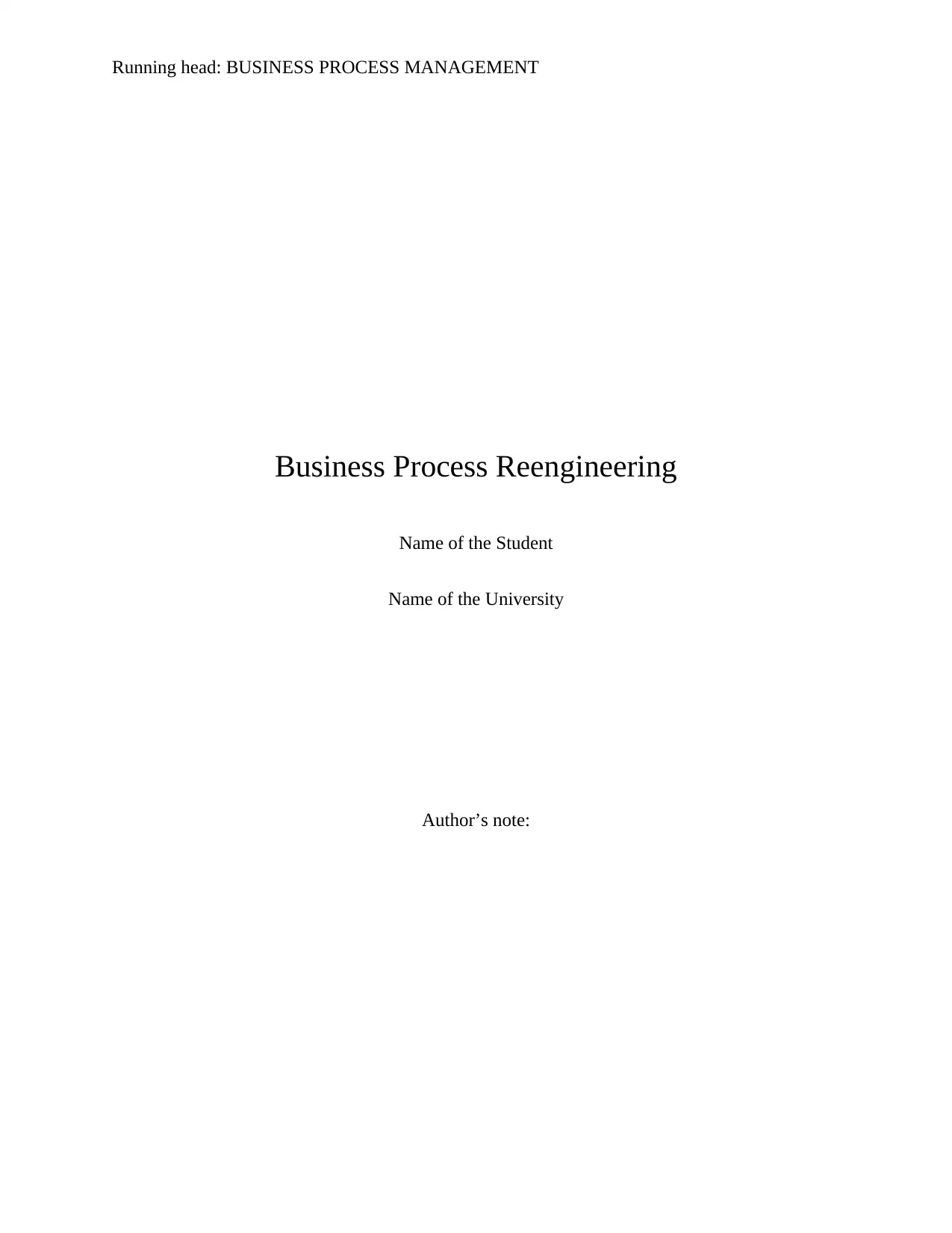
Running head: BUSINESS PROCESS MANAGEMENT
Business Process Reengineering
Name of the Student
Name of the University
Author’s note:
Business Process Reengineering
Name of the Student
Name of the University
Author’s note:
Paraphrase This Document
Need a fresh take? Get an instant paraphrase of this document with our AI Paraphraser
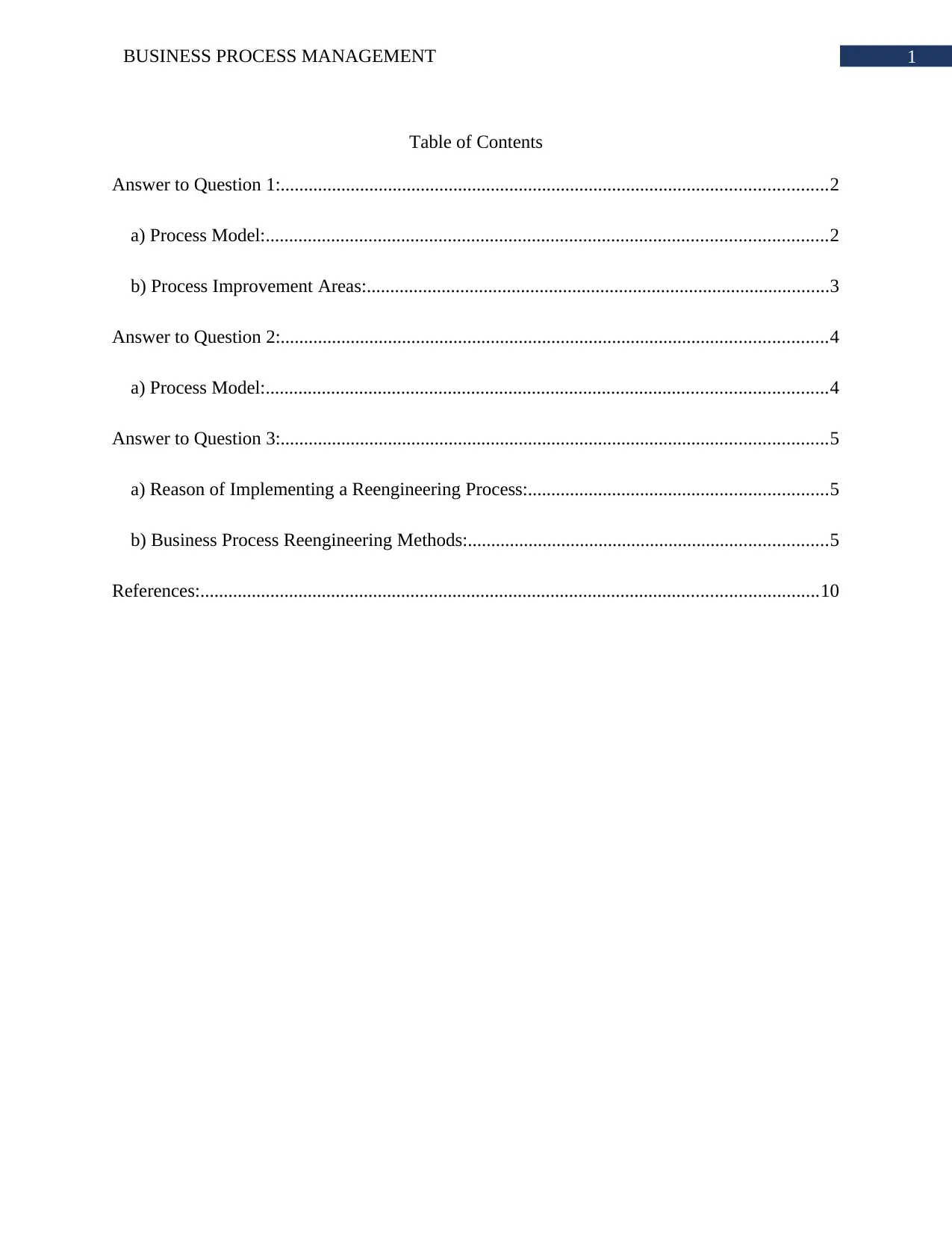
1BUSINESS PROCESS MANAGEMENT
Table of Contents
Answer to Question 1:.....................................................................................................................2
a) Process Model:........................................................................................................................2
b) Process Improvement Areas:...................................................................................................3
Answer to Question 2:.....................................................................................................................4
a) Process Model:........................................................................................................................4
Answer to Question 3:.....................................................................................................................5
a) Reason of Implementing a Reengineering Process:................................................................5
b) Business Process Reengineering Methods:.............................................................................5
References:....................................................................................................................................10
Table of Contents
Answer to Question 1:.....................................................................................................................2
a) Process Model:........................................................................................................................2
b) Process Improvement Areas:...................................................................................................3
Answer to Question 2:.....................................................................................................................4
a) Process Model:........................................................................................................................4
Answer to Question 3:.....................................................................................................................5
a) Reason of Implementing a Reengineering Process:................................................................5
b) Business Process Reengineering Methods:.............................................................................5
References:....................................................................................................................................10
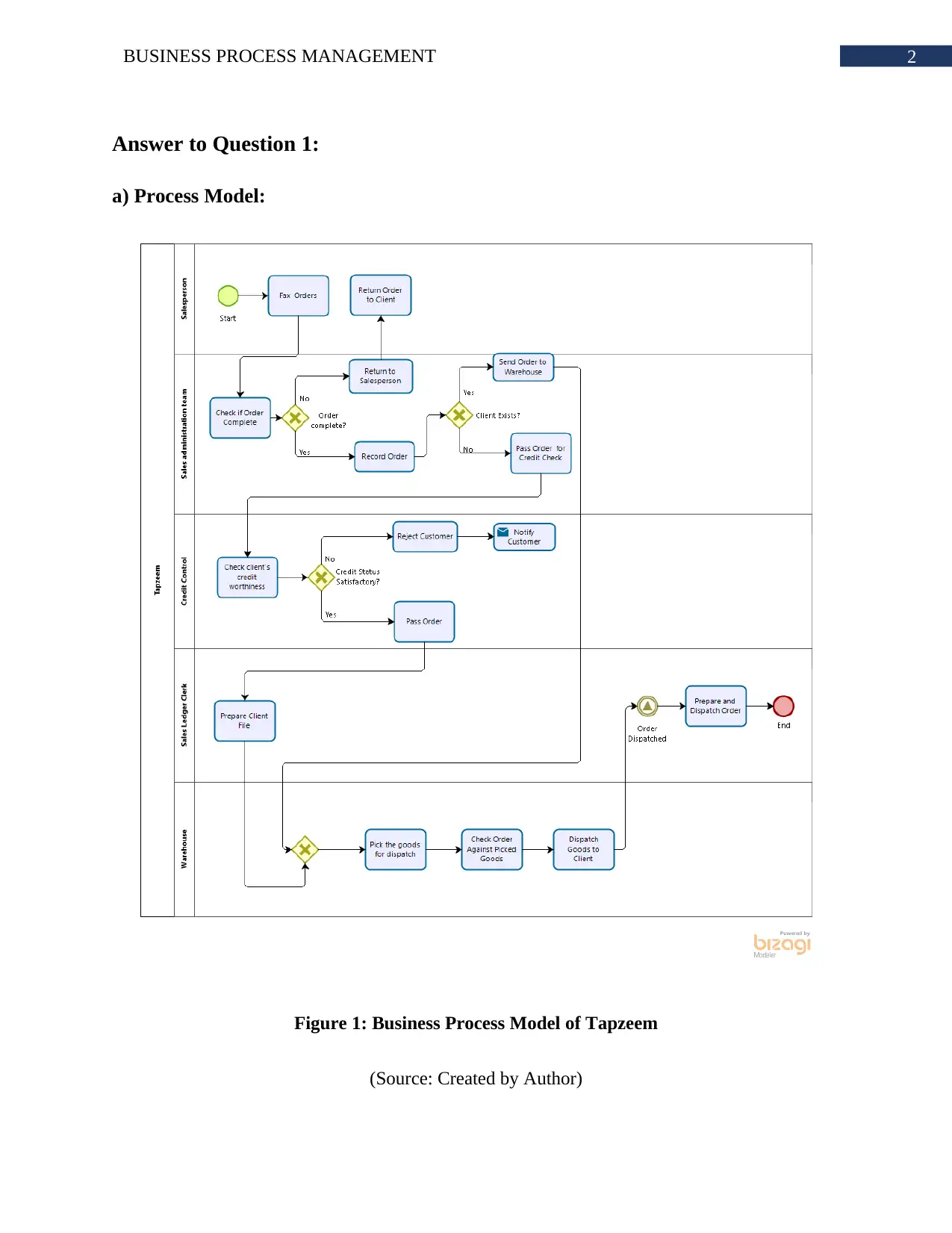
2BUSINESS PROCESS MANAGEMENT
Answer to Question 1:
a) Process Model:
Figure 1: Business Process Model of Tapzeem
(Source: Created by Author)
Answer to Question 1:
a) Process Model:
Figure 1: Business Process Model of Tapzeem
(Source: Created by Author)
⊘ This is a preview!⊘
Do you want full access?
Subscribe today to unlock all pages.

Trusted by 1+ million students worldwide
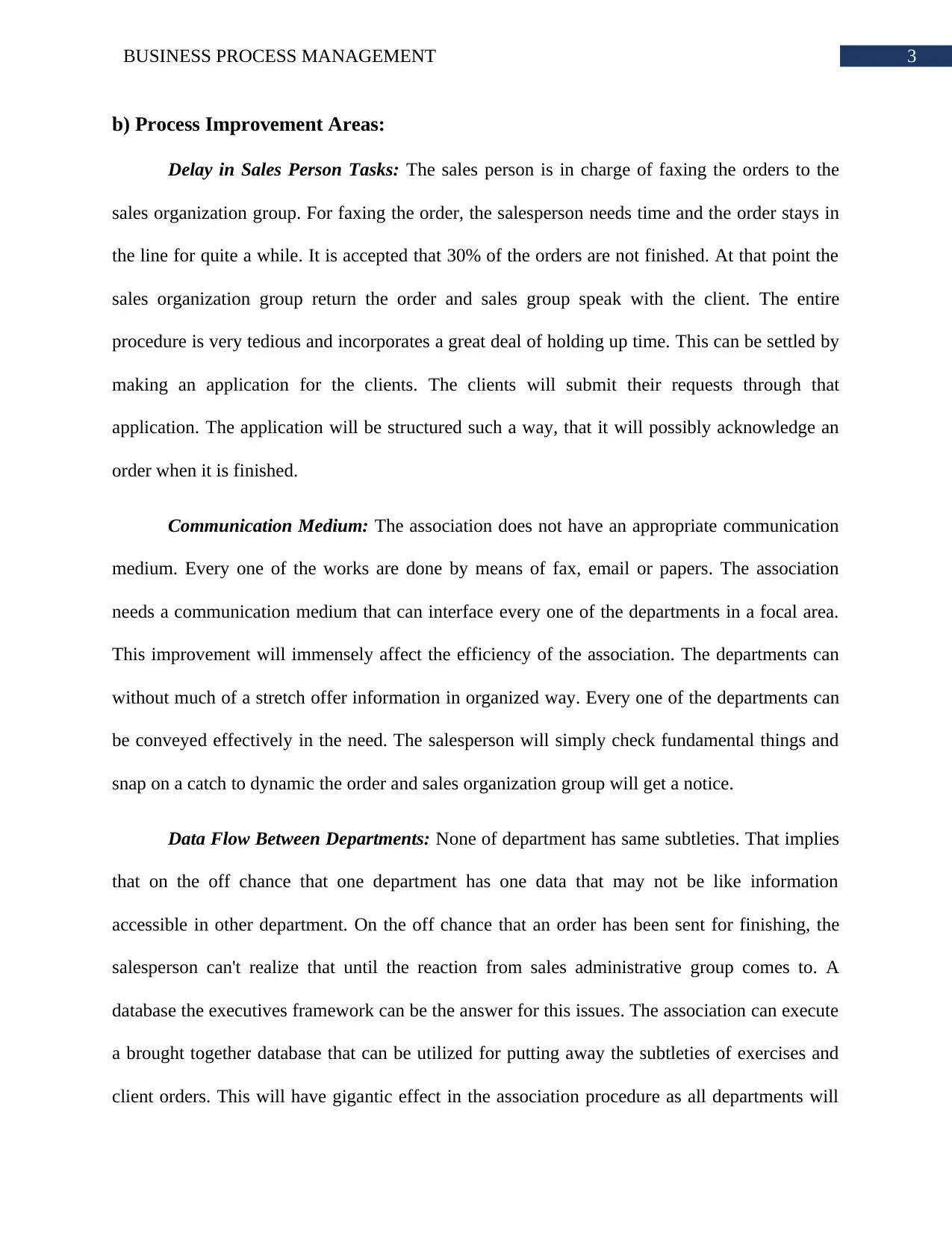
3BUSINESS PROCESS MANAGEMENT
b) Process Improvement Areas:
Delay in Sales Person Tasks: The sales person is in charge of faxing the orders to the
sales organization group. For faxing the order, the salesperson needs time and the order stays in
the line for quite a while. It is accepted that 30% of the orders are not finished. At that point the
sales organization group return the order and sales group speak with the client. The entire
procedure is very tedious and incorporates a great deal of holding up time. This can be settled by
making an application for the clients. The clients will submit their requests through that
application. The application will be structured such a way, that it will possibly acknowledge an
order when it is finished.
Communication Medium: The association does not have an appropriate communication
medium. Every one of the works are done by means of fax, email or papers. The association
needs a communication medium that can interface every one of the departments in a focal area.
This improvement will immensely affect the efficiency of the association. The departments can
without much of a stretch offer information in organized way. Every one of the departments can
be conveyed effectively in the need. The salesperson will simply check fundamental things and
snap on a catch to dynamic the order and sales organization group will get a notice.
Data Flow Between Departments: None of department has same subtleties. That implies
that on the off chance that one department has one data that may not be like information
accessible in other department. On the off chance that an order has been sent for finishing, the
salesperson can't realize that until the reaction from sales administrative group comes to. A
database the executives framework can be the answer for this issues. The association can execute
a brought together database that can be utilized for putting away the subtleties of exercises and
client orders. This will have gigantic effect in the association procedure as all departments will
b) Process Improvement Areas:
Delay in Sales Person Tasks: The sales person is in charge of faxing the orders to the
sales organization group. For faxing the order, the salesperson needs time and the order stays in
the line for quite a while. It is accepted that 30% of the orders are not finished. At that point the
sales organization group return the order and sales group speak with the client. The entire
procedure is very tedious and incorporates a great deal of holding up time. This can be settled by
making an application for the clients. The clients will submit their requests through that
application. The application will be structured such a way, that it will possibly acknowledge an
order when it is finished.
Communication Medium: The association does not have an appropriate communication
medium. Every one of the works are done by means of fax, email or papers. The association
needs a communication medium that can interface every one of the departments in a focal area.
This improvement will immensely affect the efficiency of the association. The departments can
without much of a stretch offer information in organized way. Every one of the departments can
be conveyed effectively in the need. The salesperson will simply check fundamental things and
snap on a catch to dynamic the order and sales organization group will get a notice.
Data Flow Between Departments: None of department has same subtleties. That implies
that on the off chance that one department has one data that may not be like information
accessible in other department. On the off chance that an order has been sent for finishing, the
salesperson can't realize that until the reaction from sales administrative group comes to. A
database the executives framework can be the answer for this issues. The association can execute
a brought together database that can be utilized for putting away the subtleties of exercises and
client orders. This will have gigantic effect in the association procedure as all departments will
Paraphrase This Document
Need a fresh take? Get an instant paraphrase of this document with our AI Paraphraser
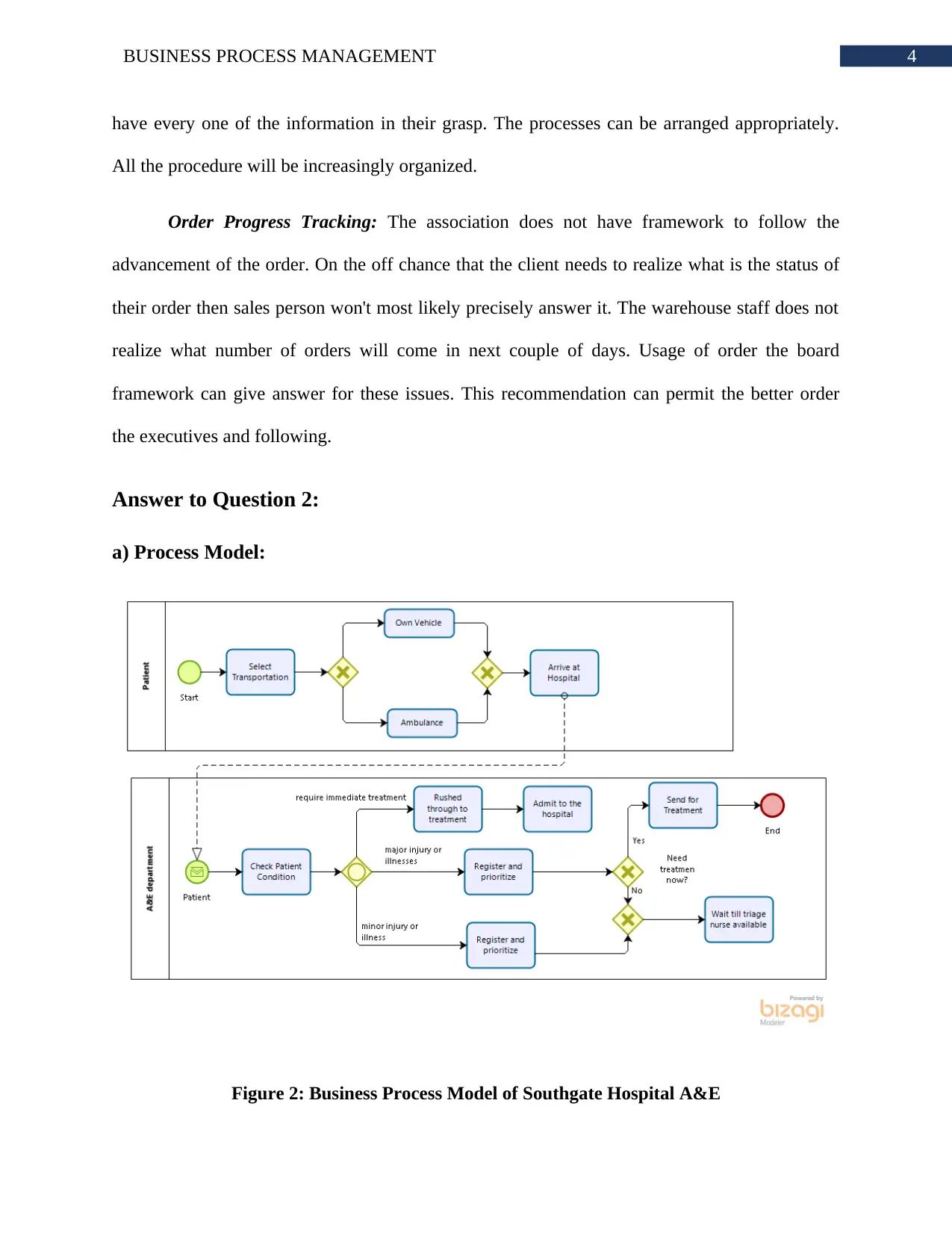
4BUSINESS PROCESS MANAGEMENT
have every one of the information in their grasp. The processes can be arranged appropriately.
All the procedure will be increasingly organized.
Order Progress Tracking: The association does not have framework to follow the
advancement of the order. On the off chance that the client needs to realize what is the status of
their order then sales person won't most likely precisely answer it. The warehouse staff does not
realize what number of orders will come in next couple of days. Usage of order the board
framework can give answer for these issues. This recommendation can permit the better order
the executives and following.
Answer to Question 2:
a) Process Model:
Figure 2: Business Process Model of Southgate Hospital A&E
have every one of the information in their grasp. The processes can be arranged appropriately.
All the procedure will be increasingly organized.
Order Progress Tracking: The association does not have framework to follow the
advancement of the order. On the off chance that the client needs to realize what is the status of
their order then sales person won't most likely precisely answer it. The warehouse staff does not
realize what number of orders will come in next couple of days. Usage of order the board
framework can give answer for these issues. This recommendation can permit the better order
the executives and following.
Answer to Question 2:
a) Process Model:
Figure 2: Business Process Model of Southgate Hospital A&E
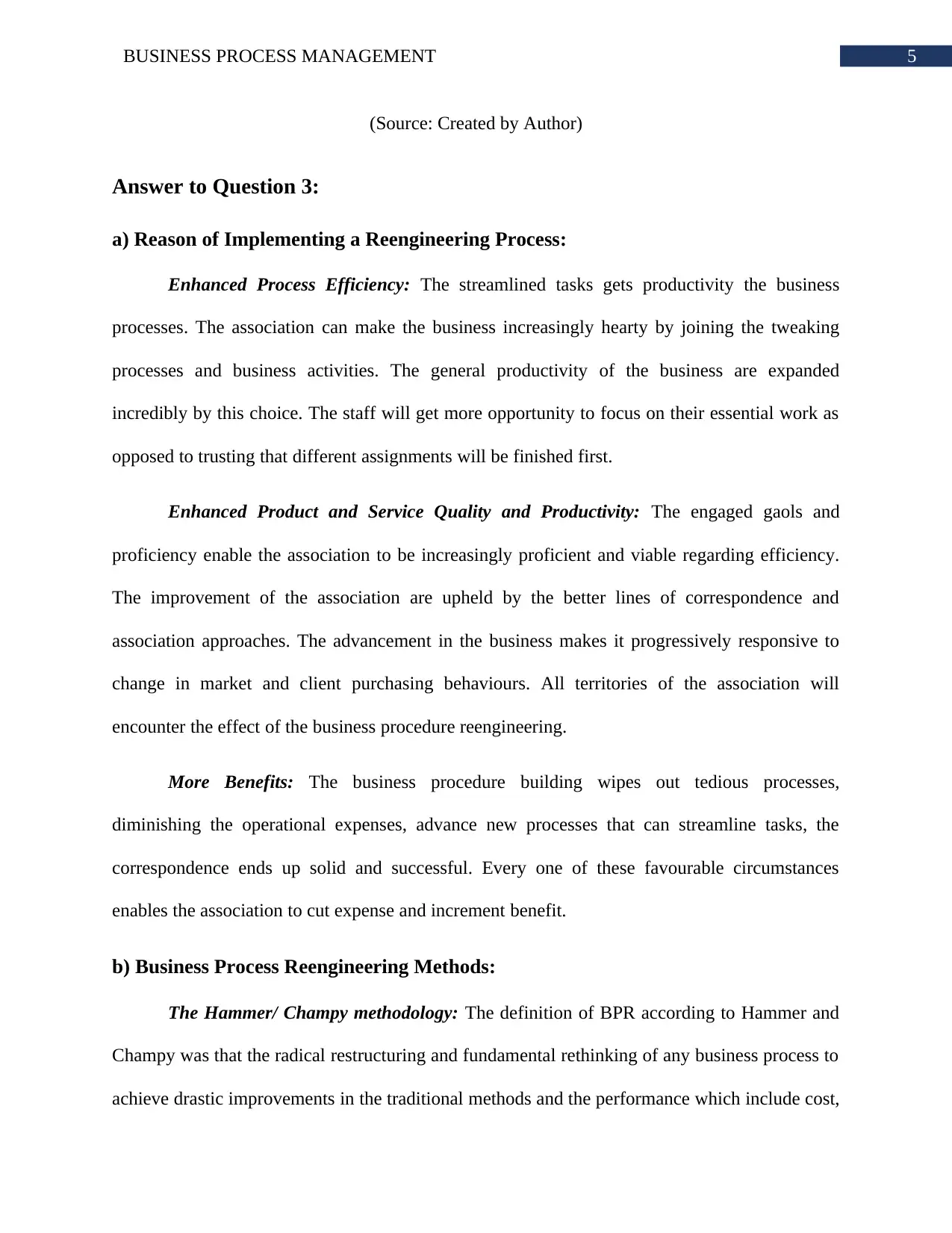
5BUSINESS PROCESS MANAGEMENT
(Source: Created by Author)
Answer to Question 3:
a) Reason of Implementing a Reengineering Process:
Enhanced Process Efficiency: The streamlined tasks gets productivity the business
processes. The association can make the business increasingly hearty by joining the tweaking
processes and business activities. The general productivity of the business are expanded
incredibly by this choice. The staff will get more opportunity to focus on their essential work as
opposed to trusting that different assignments will be finished first.
Enhanced Product and Service Quality and Productivity: The engaged gaols and
proficiency enable the association to be increasingly proficient and viable regarding efficiency.
The improvement of the association are upheld by the better lines of correspondence and
association approaches. The advancement in the business makes it progressively responsive to
change in market and client purchasing behaviours. All territories of the association will
encounter the effect of the business procedure reengineering.
More Benefits: The business procedure building wipes out tedious processes,
diminishing the operational expenses, advance new processes that can streamline tasks, the
correspondence ends up solid and successful. Every one of these favourable circumstances
enables the association to cut expense and increment benefit.
b) Business Process Reengineering Methods:
The Hammer/ Champy methodology: The definition of BPR according to Hammer and
Champy was that the radical restructuring and fundamental rethinking of any business process to
achieve drastic improvements in the traditional methods and the performance which include cost,
(Source: Created by Author)
Answer to Question 3:
a) Reason of Implementing a Reengineering Process:
Enhanced Process Efficiency: The streamlined tasks gets productivity the business
processes. The association can make the business increasingly hearty by joining the tweaking
processes and business activities. The general productivity of the business are expanded
incredibly by this choice. The staff will get more opportunity to focus on their essential work as
opposed to trusting that different assignments will be finished first.
Enhanced Product and Service Quality and Productivity: The engaged gaols and
proficiency enable the association to be increasingly proficient and viable regarding efficiency.
The improvement of the association are upheld by the better lines of correspondence and
association approaches. The advancement in the business makes it progressively responsive to
change in market and client purchasing behaviours. All territories of the association will
encounter the effect of the business procedure reengineering.
More Benefits: The business procedure building wipes out tedious processes,
diminishing the operational expenses, advance new processes that can streamline tasks, the
correspondence ends up solid and successful. Every one of these favourable circumstances
enables the association to cut expense and increment benefit.
b) Business Process Reengineering Methods:
The Hammer/ Champy methodology: The definition of BPR according to Hammer and
Champy was that the radical restructuring and fundamental rethinking of any business process to
achieve drastic improvements in the traditional methods and the performance which include cost,
⊘ This is a preview!⊘
Do you want full access?
Subscribe today to unlock all pages.

Trusted by 1+ million students worldwide
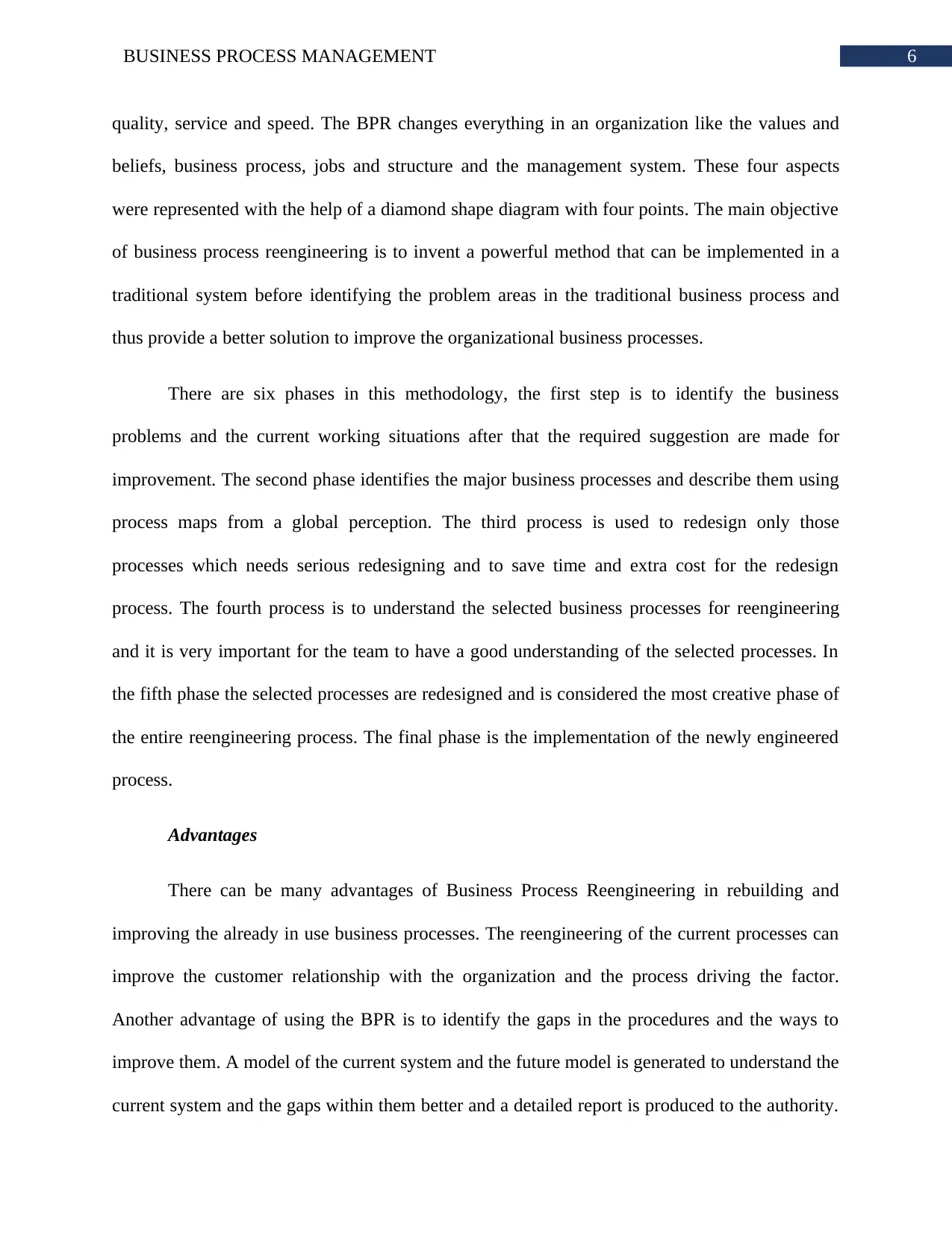
6BUSINESS PROCESS MANAGEMENT
quality, service and speed. The BPR changes everything in an organization like the values and
beliefs, business process, jobs and structure and the management system. These four aspects
were represented with the help of a diamond shape diagram with four points. The main objective
of business process reengineering is to invent a powerful method that can be implemented in a
traditional system before identifying the problem areas in the traditional business process and
thus provide a better solution to improve the organizational business processes.
There are six phases in this methodology, the first step is to identify the business
problems and the current working situations after that the required suggestion are made for
improvement. The second phase identifies the major business processes and describe them using
process maps from a global perception. The third process is used to redesign only those
processes which needs serious redesigning and to save time and extra cost for the redesign
process. The fourth process is to understand the selected business processes for reengineering
and it is very important for the team to have a good understanding of the selected processes. In
the fifth phase the selected processes are redesigned and is considered the most creative phase of
the entire reengineering process. The final phase is the implementation of the newly engineered
process.
Advantages
There can be many advantages of Business Process Reengineering in rebuilding and
improving the already in use business processes. The reengineering of the current processes can
improve the customer relationship with the organization and the process driving the factor.
Another advantage of using the BPR is to identify the gaps in the procedures and the ways to
improve them. A model of the current system and the future model is generated to understand the
current system and the gaps within them better and a detailed report is produced to the authority.
quality, service and speed. The BPR changes everything in an organization like the values and
beliefs, business process, jobs and structure and the management system. These four aspects
were represented with the help of a diamond shape diagram with four points. The main objective
of business process reengineering is to invent a powerful method that can be implemented in a
traditional system before identifying the problem areas in the traditional business process and
thus provide a better solution to improve the organizational business processes.
There are six phases in this methodology, the first step is to identify the business
problems and the current working situations after that the required suggestion are made for
improvement. The second phase identifies the major business processes and describe them using
process maps from a global perception. The third process is used to redesign only those
processes which needs serious redesigning and to save time and extra cost for the redesign
process. The fourth process is to understand the selected business processes for reengineering
and it is very important for the team to have a good understanding of the selected processes. In
the fifth phase the selected processes are redesigned and is considered the most creative phase of
the entire reengineering process. The final phase is the implementation of the newly engineered
process.
Advantages
There can be many advantages of Business Process Reengineering in rebuilding and
improving the already in use business processes. The reengineering of the current processes can
improve the customer relationship with the organization and the process driving the factor.
Another advantage of using the BPR is to identify the gaps in the procedures and the ways to
improve them. A model of the current system and the future model is generated to understand the
current system and the gaps within them better and a detailed report is produced to the authority.
Paraphrase This Document
Need a fresh take? Get an instant paraphrase of this document with our AI Paraphraser
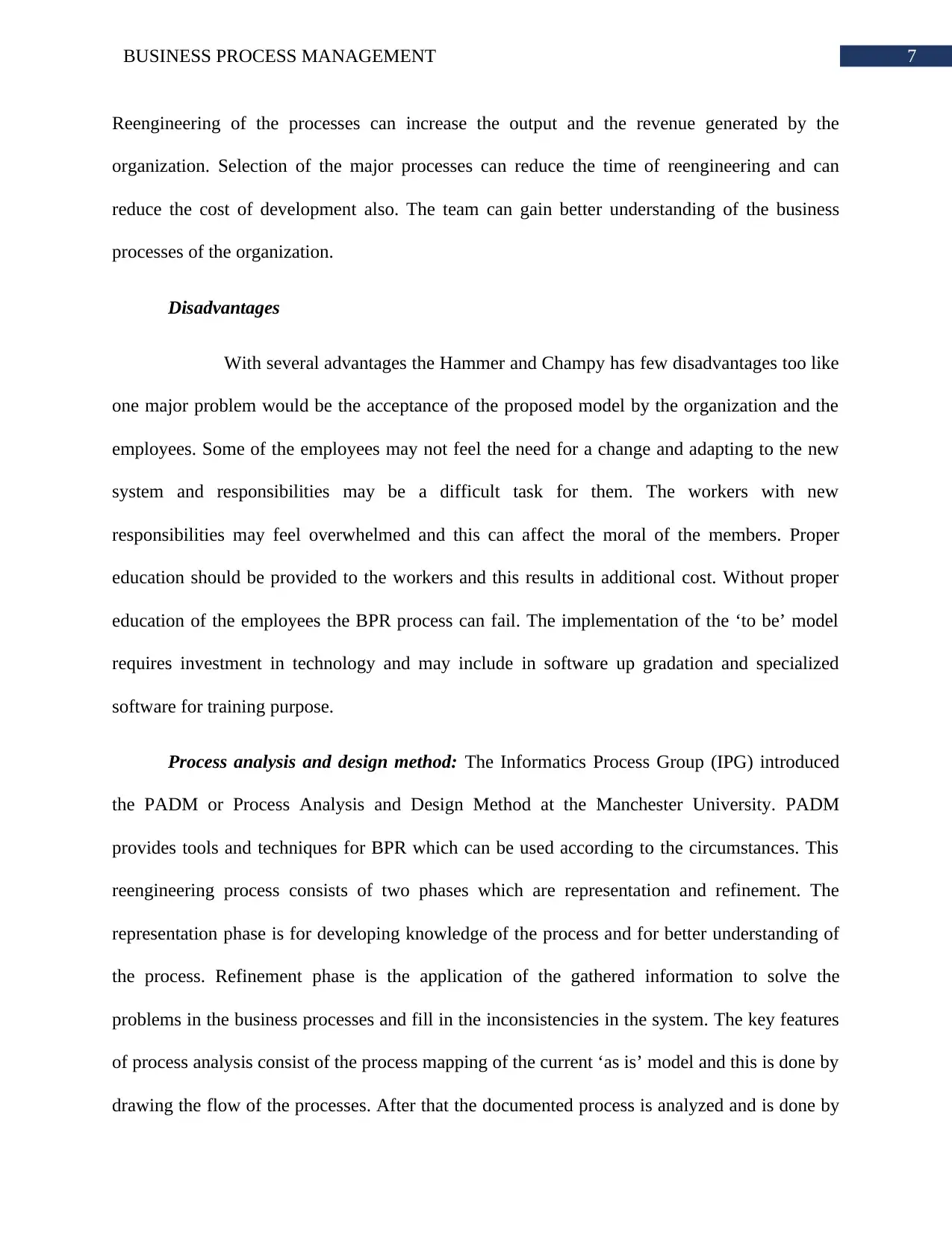
7BUSINESS PROCESS MANAGEMENT
Reengineering of the processes can increase the output and the revenue generated by the
organization. Selection of the major processes can reduce the time of reengineering and can
reduce the cost of development also. The team can gain better understanding of the business
processes of the organization.
Disadvantages
With several advantages the Hammer and Champy has few disadvantages too like
one major problem would be the acceptance of the proposed model by the organization and the
employees. Some of the employees may not feel the need for a change and adapting to the new
system and responsibilities may be a difficult task for them. The workers with new
responsibilities may feel overwhelmed and this can affect the moral of the members. Proper
education should be provided to the workers and this results in additional cost. Without proper
education of the employees the BPR process can fail. The implementation of the ‘to be’ model
requires investment in technology and may include in software up gradation and specialized
software for training purpose.
Process analysis and design method: The Informatics Process Group (IPG) introduced
the PADM or Process Analysis and Design Method at the Manchester University. PADM
provides tools and techniques for BPR which can be used according to the circumstances. This
reengineering process consists of two phases which are representation and refinement. The
representation phase is for developing knowledge of the process and for better understanding of
the process. Refinement phase is the application of the gathered information to solve the
problems in the business processes and fill in the inconsistencies in the system. The key features
of process analysis consist of the process mapping of the current ‘as is’ model and this is done by
drawing the flow of the processes. After that the documented process is analyzed and is done by
Reengineering of the processes can increase the output and the revenue generated by the
organization. Selection of the major processes can reduce the time of reengineering and can
reduce the cost of development also. The team can gain better understanding of the business
processes of the organization.
Disadvantages
With several advantages the Hammer and Champy has few disadvantages too like
one major problem would be the acceptance of the proposed model by the organization and the
employees. Some of the employees may not feel the need for a change and adapting to the new
system and responsibilities may be a difficult task for them. The workers with new
responsibilities may feel overwhelmed and this can affect the moral of the members. Proper
education should be provided to the workers and this results in additional cost. Without proper
education of the employees the BPR process can fail. The implementation of the ‘to be’ model
requires investment in technology and may include in software up gradation and specialized
software for training purpose.
Process analysis and design method: The Informatics Process Group (IPG) introduced
the PADM or Process Analysis and Design Method at the Manchester University. PADM
provides tools and techniques for BPR which can be used according to the circumstances. This
reengineering process consists of two phases which are representation and refinement. The
representation phase is for developing knowledge of the process and for better understanding of
the process. Refinement phase is the application of the gathered information to solve the
problems in the business processes and fill in the inconsistencies in the system. The key features
of process analysis consist of the process mapping of the current ‘as is’ model and this is done by
drawing the flow of the processes. After that the documented process is analyzed and is done by
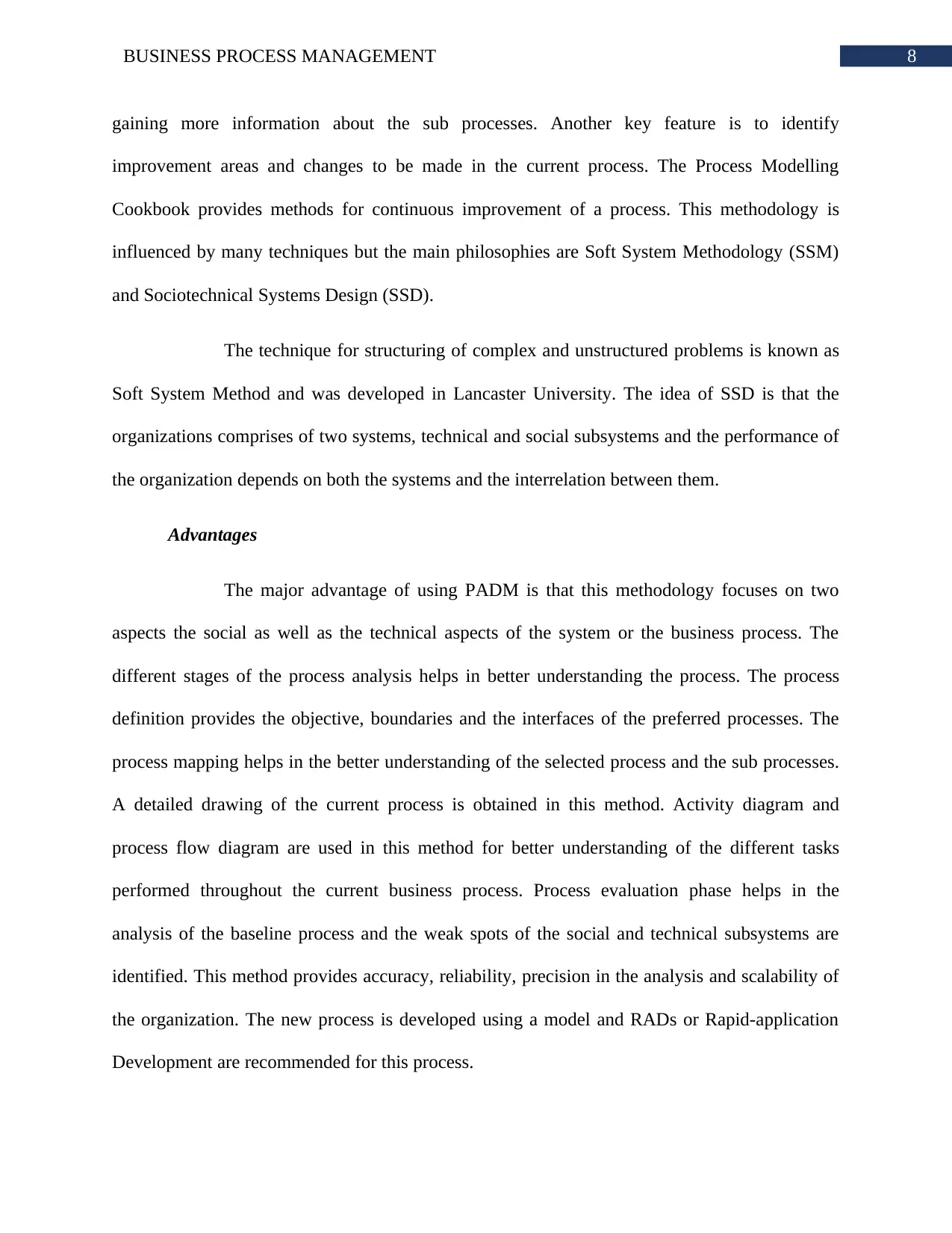
8BUSINESS PROCESS MANAGEMENT
gaining more information about the sub processes. Another key feature is to identify
improvement areas and changes to be made in the current process. The Process Modelling
Cookbook provides methods for continuous improvement of a process. This methodology is
influenced by many techniques but the main philosophies are Soft System Methodology (SSM)
and Sociotechnical Systems Design (SSD).
The technique for structuring of complex and unstructured problems is known as
Soft System Method and was developed in Lancaster University. The idea of SSD is that the
organizations comprises of two systems, technical and social subsystems and the performance of
the organization depends on both the systems and the interrelation between them.
Advantages
The major advantage of using PADM is that this methodology focuses on two
aspects the social as well as the technical aspects of the system or the business process. The
different stages of the process analysis helps in better understanding the process. The process
definition provides the objective, boundaries and the interfaces of the preferred processes. The
process mapping helps in the better understanding of the selected process and the sub processes.
A detailed drawing of the current process is obtained in this method. Activity diagram and
process flow diagram are used in this method for better understanding of the different tasks
performed throughout the current business process. Process evaluation phase helps in the
analysis of the baseline process and the weak spots of the social and technical subsystems are
identified. This method provides accuracy, reliability, precision in the analysis and scalability of
the organization. The new process is developed using a model and RADs or Rapid-application
Development are recommended for this process.
gaining more information about the sub processes. Another key feature is to identify
improvement areas and changes to be made in the current process. The Process Modelling
Cookbook provides methods for continuous improvement of a process. This methodology is
influenced by many techniques but the main philosophies are Soft System Methodology (SSM)
and Sociotechnical Systems Design (SSD).
The technique for structuring of complex and unstructured problems is known as
Soft System Method and was developed in Lancaster University. The idea of SSD is that the
organizations comprises of two systems, technical and social subsystems and the performance of
the organization depends on both the systems and the interrelation between them.
Advantages
The major advantage of using PADM is that this methodology focuses on two
aspects the social as well as the technical aspects of the system or the business process. The
different stages of the process analysis helps in better understanding the process. The process
definition provides the objective, boundaries and the interfaces of the preferred processes. The
process mapping helps in the better understanding of the selected process and the sub processes.
A detailed drawing of the current process is obtained in this method. Activity diagram and
process flow diagram are used in this method for better understanding of the different tasks
performed throughout the current business process. Process evaluation phase helps in the
analysis of the baseline process and the weak spots of the social and technical subsystems are
identified. This method provides accuracy, reliability, precision in the analysis and scalability of
the organization. The new process is developed using a model and RADs or Rapid-application
Development are recommended for this process.
⊘ This is a preview!⊘
Do you want full access?
Subscribe today to unlock all pages.

Trusted by 1+ million students worldwide
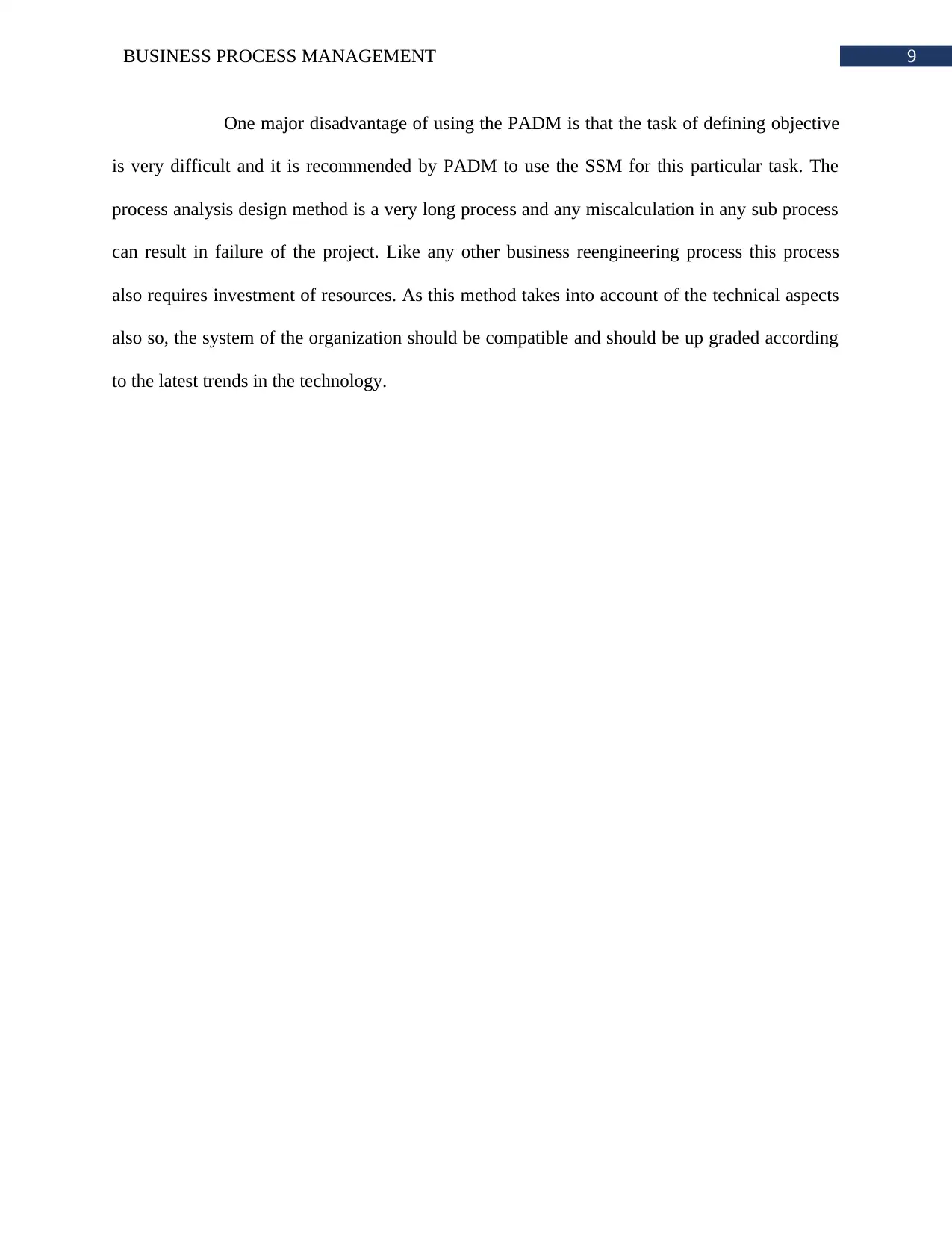
9BUSINESS PROCESS MANAGEMENT
One major disadvantage of using the PADM is that the task of defining objective
is very difficult and it is recommended by PADM to use the SSM for this particular task. The
process analysis design method is a very long process and any miscalculation in any sub process
can result in failure of the project. Like any other business reengineering process this process
also requires investment of resources. As this method takes into account of the technical aspects
also so, the system of the organization should be compatible and should be up graded according
to the latest trends in the technology.
One major disadvantage of using the PADM is that the task of defining objective
is very difficult and it is recommended by PADM to use the SSM for this particular task. The
process analysis design method is a very long process and any miscalculation in any sub process
can result in failure of the project. Like any other business reengineering process this process
also requires investment of resources. As this method takes into account of the technical aspects
also so, the system of the organization should be compatible and should be up graded according
to the latest trends in the technology.
Paraphrase This Document
Need a fresh take? Get an instant paraphrase of this document with our AI Paraphraser
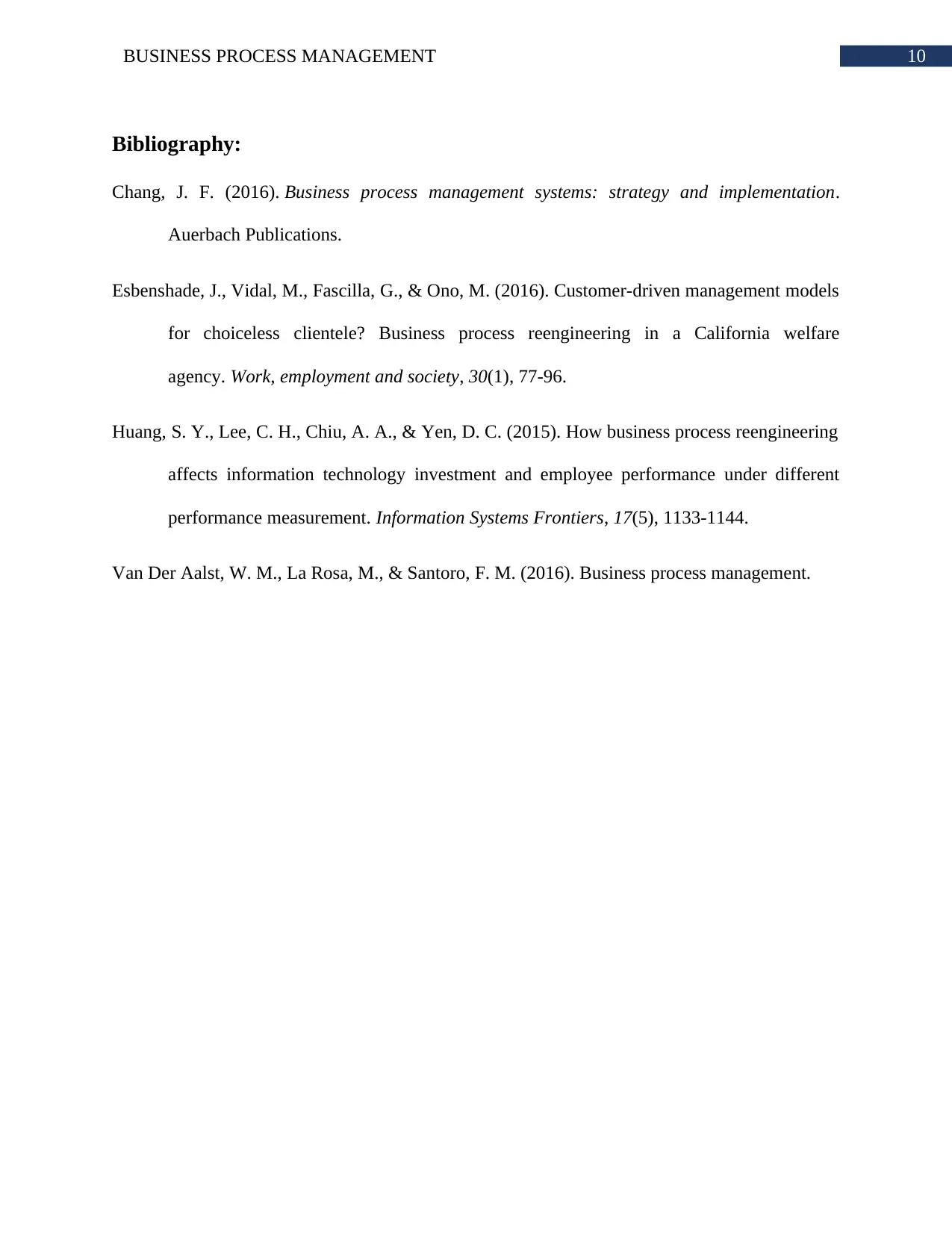
10BUSINESS PROCESS MANAGEMENT
Bibliography:
Chang, J. F. (2016). Business process management systems: strategy and implementation.
Auerbach Publications.
Esbenshade, J., Vidal, M., Fascilla, G., & Ono, M. (2016). Customer-driven management models
for choiceless clientele? Business process reengineering in a California welfare
agency. Work, employment and society, 30(1), 77-96.
Huang, S. Y., Lee, C. H., Chiu, A. A., & Yen, D. C. (2015). How business process reengineering
affects information technology investment and employee performance under different
performance measurement. Information Systems Frontiers, 17(5), 1133-1144.
Van Der Aalst, W. M., La Rosa, M., & Santoro, F. M. (2016). Business process management.
Bibliography:
Chang, J. F. (2016). Business process management systems: strategy and implementation.
Auerbach Publications.
Esbenshade, J., Vidal, M., Fascilla, G., & Ono, M. (2016). Customer-driven management models
for choiceless clientele? Business process reengineering in a California welfare
agency. Work, employment and society, 30(1), 77-96.
Huang, S. Y., Lee, C. H., Chiu, A. A., & Yen, D. C. (2015). How business process reengineering
affects information technology investment and employee performance under different
performance measurement. Information Systems Frontiers, 17(5), 1133-1144.
Van Der Aalst, W. M., La Rosa, M., & Santoro, F. M. (2016). Business process management.
1 out of 11
Related Documents
Your All-in-One AI-Powered Toolkit for Academic Success.
+13062052269
info@desklib.com
Available 24*7 on WhatsApp / Email
![[object Object]](/_next/static/media/star-bottom.7253800d.svg)
Unlock your academic potential
Copyright © 2020–2025 A2Z Services. All Rights Reserved. Developed and managed by ZUCOL.




